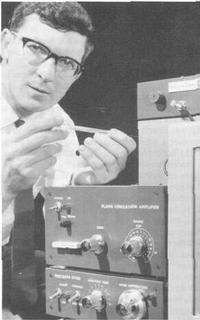


Chapter 9
I Introduction
II The Australian Chemical Industry
III Pharmaceuticals
IV Chemists In Other Industries
V The Dawn Of Modern Chemical Industry - High Pressure Synthesis
VI The Growth Of Synthetic Chemicals - Concentration, Rationalisation And International Links
VII Australian Industrial Chemical Research Laboratories
i Australian instrument inventions
ii Plant protection - overseas and in Australia
iii Successes in the laboratory but . . .
iv Drugs for sheep and cattle revisited Tetramisole - international success and local manufacture
v 'Promicide'* 'Grenade'* to control ticks
vi Technical service R&D
vii Industry/CSIRO/university collaboration
viii Australian entrepreneurs in modern chemistry
VIII The Plastics Industry
IX The Paint Industry
X Acknowledgements
References
Index
Search
Help
Contact us

R. A. Dewar was one of the first people to see this need. In 1956, the first year of operation of ICI's Central Research Laboratory, he initiated a project aimed at improved organic analysis as a tool to better process control. A young researcher, lan McWilliam, was given the task. McWilliam realised that the components could be detected by conductivity measurements if only they could be ionised as they came off the column. He built several devices for bombarding the output vapours with electrons in order to ionise them without achieving the required sensitivity. He then tried to measure the ionisation produced by burning the sample components with the hydrogen/nitrogen carrier gas mixture in air. This produced the effect he sought; after some further refinement during 1957 the flame ionisation detector was operative -a new tool capable of measuring one part in 10 million (Figs. 20 and 21).[88][89] For decades the FID has been used throughout the world. More than 100,000 detectors have been manufactured under licence from ICI Australia by some 40 instrument companies. Chromatographs equipped with flame ionisation detectors have been essential for chemical analysis in the petroleum and petrochemical industries, in medical and biochemical research and for pollution control. It is probably no exaggeration to say that no other instrument has done more for the detection of emissions and environmental control.


Before the industrial use of the FID was developed commercially, another fundamental tool was discovered by ICI workers. Following up Walsh's work on atomic absorption spectroscopy George Isaak found, in 1959, that very narrow spectra could be resolved[90] and analysed by absorbing a narrow slit from a resonantly scattered beam of light in a vapour chamber and shifting the spectrum of the vapour by an electric or magnetic field. It seemed an extremely sophisticated and fundamental further advance -so specific that indeed no uses could be found for it, at least for a long time -and even then the results remained of academic, albeit fundamental value.
Both McWilliam's and Isaak's inventions -although at the opposite poles of ultimate practical utility -had one thing in common in the hands of a chemical company, they were so-called 'fall-out' inventions. To the chemical industry the flame ionisation detector was merely a valuable tool and not part of the company's core business skills and markets. There was no use in sight for Isaak's high resolution scanning spectroscope and gas chromatography was still in its infancy; alternative detectors to McWilliam's were available and there was no sizeable instrument manufacture in Australia.
Should a chemical company have changed direction, on the basis of one component of one instrument, with but a few instruments sold, at the time, on the local market? After long deliberations, wide consultation overseas and faced with many new developments in its core business, chemistry, competing for funds the Company decided for a program of international licensing. This was a success in terms of royalties earned for Australia -a couple of million dollars -with a minimum of capital and effort invested. Whether it was an opportunity missed -in the light of a number of instrument inventions made in Australia in later years which might have led to a significant portfolio of products -will never be known.
Organisations in Australian Science at Work - I.C.I. Australia Ltd. Central Research Laboratories
People in Bright Sparcs - Dewar, R. A.; Isaak, George; McWilliam, Ian
 |
Australian Academy of Technological Sciences and Engineering |  |
© 1988 Print Edition pages 681 - 682, Online Edition 2000
Published by Australian Science and Technology Heritage Centre, using the Web Academic Resource Publisher
http://www.austehc.unimelb.edu.au/tia/649.html